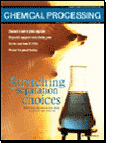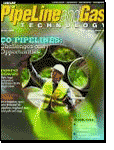Recommended :
Subscribe FREE - Chemical Processing
 Two main group of pressure relief devices are accepted as ultimate or final safeguarding device against overpressure protection of pressure contained equipments. There are reclosable type (pressure relief valve) and non-reclosable type (rupture disc). Both type of devices have been used in different application with their special reclosable and non-reclosable characteristic. Nevertheless, in some application, rupture disc (RD) and pressure relief valve (PRV) are use in combination. They have been applied such that RD is located upstream of PRV.
Two main group of pressure relief devices are accepted as ultimate or final safeguarding device against overpressure protection of pressure contained equipments. There are reclosable type (pressure relief valve) and non-reclosable type (rupture disc). Both type of devices have been used in different application with their special reclosable and non-reclosable characteristic. Nevertheless, in some application, rupture disc (RD) and pressure relief valve (PRV) are use in combination. They have been applied such that RD is located upstream of PRV.
Subscribe FREE - Chemical Processing
 Two main group of pressure relief devices are accepted as ultimate or final safeguarding device against overpressure protection of pressure contained equipments. There are reclosable type (pressure relief valve) and non-reclosable type (rupture disc). Both type of devices have been used in different application with their special reclosable and non-reclosable characteristic. Nevertheless, in some application, rupture disc (RD) and pressure relief valve (PRV) are use in combination. They have been applied such that RD is located upstream of PRV.
Two main group of pressure relief devices are accepted as ultimate or final safeguarding device against overpressure protection of pressure contained equipments. There are reclosable type (pressure relief valve) and non-reclosable type (rupture disc). Both type of devices have been used in different application with their special reclosable and non-reclosable characteristic. Nevertheless, in some application, rupture disc (RD) and pressure relief valve (PRV) are use in combination. They have been applied such that RD is located upstream of PRV.What is the main purpose and advantages by placing RD upstream of PRV ?
To answer this question, it can be answered from several aspects :
- Safety
- Environment
- Cost
Equipment with fluid contain particles, solid, substances may freeze, crystallize & polymerize, etc, these substances potential stay and stick to the nozzle and PSV inlet pipe. It potentially lead to reduced flow path area and reduce flowing capacity of the relief flow path. Reduced flow would lead to overpressure and catastrophe event. Apart, reduced flow path increases inlet line frictional lose (more than 3% of set pressure) and potentially cause PSV chattering and damage. Providing RD upstream of PRV would avoid these substances accumulate at the inlet nozzle and pipes.
Prevent Opening of PRV (Safety)
As solid substance can contacts with PRV disc and seat, it may stick to the disc and seat and solidify. Sticked substance may prevent PRV from opening or increases force (pressure) to open the PRV. This potentially cause internal pressure exceeded Maximum Allowable Working Pressure (MAWP) of the protected equipment and lead to catastrophe event. Providing RD upstream of PRV would avoid these substances contact with PRV's disc and seat.
PRV "Slow" Action (Safety)
This has been discussed in "Tube Rupture : Pressure Relief Valve (PSV) or Rupture Disk (RD) ?". In the event liquid in Low Pressure Side (LPS), sudden tube rupture may generate a huge surge pressure to the LPS within a mili-second and results the intermittent peak pressure exceeded design pressure of LPS, pressure relief valve (PRV) is NOT recommended in this case. Pressure relief valve is known to be a “slow acting device”, it may NOT response fast enough to relieve pressure. Thus, a rupture disk which known as “quick acting device” is always recommended in this case.
 PRV Passing / Leaks (Environment & Health)
PRV Passing / Leaks (Environment & Health)PRV passing and leaks is one of the common phenomenon and difficult to avoid. Continuous leaking toxic substances to atmosphere would lead to pollution (environment issue) and contact with human (health issue). Providing a RD could prevent continuous leakage.
Corrosive Fluid Corrode PRV (Capital Cost)
Corrosive fluid contact with PRV would required a Corrosion Resistance Material (CRA) PRV. It will be less expensive with corrosion resisted (CRA) RD and non-corrosion resisted (non-CRA) PRV.
Longer Overhaul/Maintenance Period (Maintenance Cost)
As fluid is not in contact with PRV (with RD upstream), the PRV is considered rather "clean" and "new". Thus, a longer period of between each Overhaul/maintenance can be extended. This indirectly reduce maintenance cost.
Extended PRV Life Span (Maintenance Cost)
Similar to above, fluid is not in contact with PRV, the PRV is considered rather "clean" and "new" and life span of PRV is extended.
Extended PRV Life Span (Maintenance Cost)
Similar to above, fluid is not in contact with PRV, the PRV is considered rather "clean" and "new" and life span of PRV is extended.
Thus, RD / PSV combination in many events could increase safety and reduce environment impact and cost.
Related Post
- Why Two Rupture Discs in Series ?
- Tube Rupture : Pressure Relief Valve (PSV) or Rupture Disk (RD) ?
- Criteria for Requirement of Pressure Relief Device for Tube Rupture
- Some Comments on Providing External Insulation as Protective Measure against FIRE
- Protective Measures against FIRE other than Pressure Relief Device (PRD)
- Design Temperature (Td) versus Maximum Allowable Working Temperature (MAWT)
- PSV for Shell-and-Tube HEX Tube Side Overpressure Protection against External Fire Attack ?
No comments:
Post a Comment